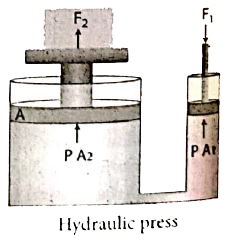Saved Bookmarks
| 1. |
Define pascal's law. Explain the application of pascal's law in our daily life. |
|
Answer» <P> Solution :Pascal.s law states that the external pressure applied on an incompressible liquid is transmitted uniformly throughout the liquid. Pascal.s law became the basis for one of the important machines ever developed, the hydraulic press. It consists of two cylinders of different cross-sectional areas. They are fitted with pistons of cross-sectional areas "a" and "A". The OBJECT to be compressed is placed over the PISTON of large cross-sectional area A. The force `F_(1)`is applied on the piston of small cross-sectional area a .The pressure produced by small piston is transmitted equally to large piston and a force `F_(2)`actson A which is much larger than `F_(1)`.Pressure on piston of small area .a. is given by, `P = F_(1)//A_(1)` ..................... (1) Applying I.ascal.s law, the pressure on large piston of area A will be the same as that on small piston. Therefore, `P = F_(2)//A_(2)` ........................(2) Comparing equations (1) and (2).we get `F_(1)//A_(1) = F_(2)//A_(2) " or " F_(2) = F_(1)x A_(2)//A_(1)` Since, the ratio `A_(2) //A_(1)` is GREATER than 1, the force `F_(2)`that acts on the larger piston is greater than the force `F_(2)` acting on the smaller piston. Hydraulic systems working in this way are known as force multipliers. 
|
|
Discussion
No Comment Found
Related InterviewSolutions
- A uniform cylindrical body when placed in liquid a floats with one third of its length outside the liquid. When placed in liquid B, it floats with one third of its length immersed in the liquid. When the body is made to float vertically in a homogeneous mixture of equal volumes of the two liquids, 25 cm of its length is seen in air. Find the length of the body.
- The place of human being in food chainin an ecosystem is as a:
- The velocities of sound waves in four media P,Q,R and S are 18,000 km//h, 900 km//h, 0km//h, and 1200 km/h respectively. Which medium could be a liquid substance?
- Calculate the wavelength of a sound wave whose frequency is 220Hz and speed is 440 m/s in a given medium.
- A metallic sphere is made of an alloy of metels 'P' and 'Q' having specific gravities (or relative densities) 20 and 2, respectively. The sphere weighs 120 g_(wt) in air and 90 gwt in water. Find the percentage of the mass of metal 'P' in the alloy.
- State whether the following statements are true or false: (a) A falling stone also attracts the earth. (b) The force of gravitation between two objects depends on the nature of medium between them. The value of G on the moon is about one-sixth((1)/(6)) of the value of G on the earth. (d) The acceleration due to gravity acting on a freely falling body is directly proportional to the mass or the body.The weight of an object on the earth is about one-sixth of its weight on the moon.
- A body of density rho is immersed in a liquid of density rho_(L).State condition when the body will (i) float (ii) sink in liquid.
- The speed-time graphs for three objects X, Y and Z are represented on the same graph paper. Which object would cover the highest distance in given interval of time (t)?
- For a given glass prism, as the angle of incidence increases, theangle of emergence __________ .
- Calculate the potential difference across the ends of a wire of resistance 2 Omega' when a current of 1.5 A passes through it.